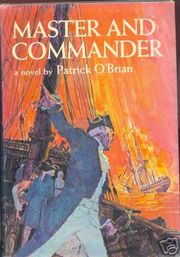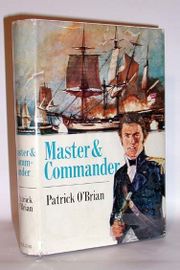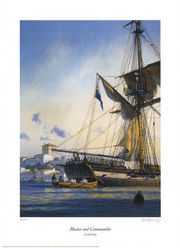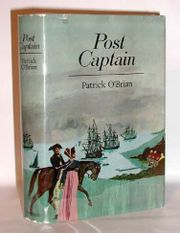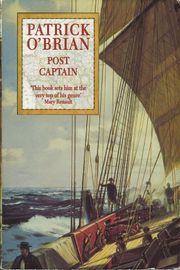Book Covers
From WikiPOBia
m (→1969 J. B. Lippincott) |
m (→1970 Collins) |
||
| Line 37: | Line 37: | ||
=== 1970 Collins === | === 1970 Collins === | ||
''Artist Dell'Orco'' [[Image:M&C Collins 1st cover.jpg|right|thumb|Collins 1st edition cover]] | ''Artist Dell'Orco'' [[Image:M&C Collins 1st cover.jpg|right|thumb|Collins 1st edition cover]] | ||
| + | |||
| + | |||
| + | |||
| + | |||
| + | |||
| + | |||
| + | |||
| + | |||
| + | |||
| + | |||
| + | |||
| + | |||
| + | |||
| + | |||
| + | |||
| + | |||
| + | |||
| + | |||
| + | |||
| + | |||
| + | |||
| + | |||
| + | |||
| + | |||
| + | |||
| + | |||
| + | |||
| + | |||
| + | |||
| + | |||
Revision as of 20:13, 12 February 2008
Contents |
Master and Commander
1969 J. B. Lippincott
1970 Collins
Artist Dell'Orco
W. W. Norton and Harper Collins (most later editions, hardcover and paperback)
Artist Geoff HuntThe Geoff Hunt cover illustration for Master and Commander shows a Mediterranean harbor scene, Port Mahon in Minorca. Judging from the shadows, and the lack of hammocks in the nettings, it could be a late spring or early summer morning, around 7 bells in the morning watch.
The British brig-sloop is presumably the Sophie, with Jack Aubrey pacing the quarterdeck in his Commander's dress uniform, single epaulette on the left shoulder, and hat worn athwartships. The Sophie is either at anchor or moored to a buoy such as the one shown in the foreground. With the light breeze coming from aft, it is curious that the ship is not being swung about to point into the wind; perhaps there are unseen lines mooring it both fore and aft.
Only the main mast is visible. Among the sails, most prominent is the fore and aft main sail, bent to the gaff and boom. If the Sophie were a three masted ship, this sail might be called the spanker. The main yard carries a tightly furled square main sail. One or the other might be used depending on the wind direction, but rarely both at the same time. The square main sail was a bit of an innovation in 1800; in earlier years brigs did not generally carry one.
The next yard up is the main topsail yard, lowered down onto the cap. The topsail is partly unfurled, with the lower corners 'clewed up'. At the very top of the picture is a hint of the topgallant yard, also lowered onto its cap. On both the main and topsail yard, there are extendable booms for the stunsails. Of the rigging, the darker lines are standing rigging, fixed tarred support lines. The lighter brown lines are running rigging, meant to be be hauled upon to move the yards and adjust the sails.
Two of the Sophie's 4-lbers are visible through open gunports in the waist. A third is visible on the quarterdeck. Other small rectangular openings in the hull are scuttle ports for ventilation and pumping out water. Jack's cabin is a bit lower than the main deck, too close to the water line to allow for any gunports.
The ensign that is flying from the peak of the gaff is the proper flag for 1800, the year before the union with Ireland added the cross of St Patrick. But Geoff Hunt may have nodded when he chose to paint the blue ensign; Admiral Keith was Vice Admiral of the White in 1800.
A four-oared jolly boat or yawl is being rowed past, carrying a lieutenant in his undress uniform, hat worn fore and aft in the modern style. Could this be Lt. Dillon, returning to the Sophie? If so, one might expect him to be facing the other way, observing the ship and clear of the side that will come alongside the entry port. The boat's crew is very nicely turned out with matching outfits and black kerchiefs around their necks. Perhaps they are just rowing past on their way to some crack frigate.
Post Captain
1972 Collins
Artist Dell'Orco1972 J. B. Lippincott
Artist Gordon Johnson
The cover illustration for the original US Lippincott edition of Post Captain in 1972 seems more appropriate for a romance novel. Jack is portrayed as a slim handsome man with light brown hair with just a hint of a ponytail. Standing on the quarterdeck in the midst of a battle, he is scowling and brandishing his sword at some unseen enemy off-stage to the right. A lovely dark-haired damsel, a shawl draped demurely around her shoulders, is gazing fondly at Jack from the foot of the mainmast. Off in the distance is a two decker ship of the line, her mizzen mast blown to a stump, but all plain sail set on the fore and main masts.
W.W. Norton and Harper Collins
Artist Geoff Hunt (most later editions, hardcover and paperback)
The scene is viewed from the proximity of the quarterdeck, looking forward towards the larboard side and bow. In the lower right foreground is one of the ship's boats on the booms over the waist. The seaman on the left is walking along the larboard gangway, next to some hammock nettings that are covered with canvas.
Three guns are visible, two nine pounder long guns and a 32 pounder carronade being fired in the bows. Captain Aubrey is standing on the railing, wearing his hat athwartship, and two epaulettes on his uniform (although he is rightly entitled to just one as a junior post captain in 1804). A small gun crew on the forecastle has just fired the bow chaser using a linstock rather than lanyard and flintlock, observed by a Lieutenant (possibly Tom Pullings) wearing his hat fore and aft.
The immediate question is whether this is meant to be the Polychrest or the Lively. The two long guns suggest that it is the Lively, because the Polychrest was armed entirely with carronades. Only the bow gun here is a carronade (note the different type of gun carriage, the large diameter, and and the elevation screw instead of a quoin). The Lively is officially listed as being armed with only a single nine pounder and a 32 pounder carronade on each side of the forecastle, but she did have three ports, so it is not unlikely that she might have carried an extra gun.
The mast seen is the foremast, with both a forecourse having two rows of reef points, and a fore topsail shown, The yards are braced for the larboard tack, with the wind coming from the larboard side. The seas must be fairly lively, because the ship's roll has temporarily slanted the deck toward the larboard side.
The next question is what scene from PC does the cover portray. The first thought might be that this is the chase scene at the very end, when Lively goes after Fama. But there is too little activity to suggest a ship still in action. Only the bow chaser is manned, by a minimal crew. It might also be just an ordinary gun exercise. However, there is no gun captain aiming the gun, the gun crew is too small, and with the gun fired on the downroll with the deck slanted so, it looks as though any shot would plow right into the sea. Perhaps there is some sail sighted ahead, and the bow chaser is being fired only as a signal.
Another item of note is that if you follow the shrouds up to the top, you can see part of the catharpins. Not Jack's beloved cross-catharpins, but just the ordinary straight across kind.
